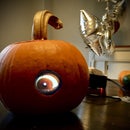Introduction: Polar Express Volume Modification
Our 4 year old son loves trains, especially steam trains.
So when we saw the Polar Express G-gauge electric train by Lionel on sale, we asked Santa to grab it. :)
Needless to say, he loves it and has been running it non-stop since opening it Christmas morning... however...
Santa's elf engineers (har har, what a pun!) did a great job on the detail, ease of use and mechanics of the train, but these elves are either psychotic masochists or just plain forgot to put a volume / mute option on the engine to prevent mommy and daddy from getting headaches.
The train makes, well... train noises the entire time it's switched on, as well as having remote control buttons that make Tom Hanks shout out lines from the movie, blow it's whistle and ding a bell that will drill directly into your soul.
After a day of this, I decided to pop open the engine and add volume control, for the sake of everyone's sanity. :)
Step 1: Cracking Open the Egg.. Err.. Engine
The engine is where all the electronic goodies are housed.
It's also the source of all the noise.
To remove the housing, remove the battery cover then pop the 6 "C" cell battery sled out of the engine.
Along the bottom of the train, there are 6 black screws. 3 on each side. Don't confuse them with the smaller screws that are more towards the center of the engine bottom. These center screws hold the motor / gear cover on. We don't want or need to access this area.
There is also a single screw at each end of the train, holding the swiveling 2-2 wheels on. Leave them, we don't need to remove these wheels to remove the upper covering.
Once you have removed the 6 correct screws (two at each end, and two in the middle at the edges between the drive wheels), you should be able to gently lift the upper portion of the engine off.
The front cowcatcher will fall off when you pull the body from the base. This is easily placed back on during reassembly.
Note that there are wires connecting the top on/off switch and LED... so don't yank it off roughly or pull it too far from the base of the engine.
Also, watch the grey push rods on the wheels, they will slide out of the top covering when you pop it off, make note/tape a photo of how to slip them back on for when it's time to reassemble. :)
Step 2: Reveal the Evil Speaker
Once the engine cover is off, you will see a black cylindrical shape with holes in the top held in place by two screws, one on each side at a 45 degree angle to the engine body.
There will also be tie wrapped wires running into/around this cylinder.
Remove the two screws, snip the tie wrap and gently lift the cylinder off. This will reveal the cause of our pain... the speaker.
Lift the speaker out and with the speaker removed, you can see the holes in the bottom of the engine letting the sound get out to torment parents.
Make note of this, because if you're adding an adjustable volume control, this is where we can mount the potentiometer (ok ok, rheostat).
If you're just going to set the volume level lower and not add an adjustable level feature, then don't worry about the little holes at the bottom and skip the potentiometer parts in the next step.
Just add your resistor of choice.
Step 3: Connecting Auditory Salvation
Cut one of the wires (mine were yellow) going to the speaker. It doesn't matter which wire on which side of the speaker.
If you are only looking to lower the volume level to a reasonable level and NOT have the ability to adjust it, then solder your resistor in series to the wire you just cut.
However, if you want the ability to adjust (or completely mute) the audio volume, then read on...
I used a small potentiometer in series on this cut speaker wire to give me the ability to adjust the volume from zero to full blast.
The extra resistor pictured in my photos is because I only had a 10K potentiometer, which was far too high a value. A slight turn would take the volume from full to 100% muted. So I added a lower resistor value in parallel with the potentiometer (rheostat) to give it a much lower resistance range and thus, easier to adjust the volume level.
If you have a properly sized potentiometer, then ignore the resistor hack I had to do.
Connect your potentiometer from one tap to the wiper's tap. So only 2 taps are being used. This is why it's actually a rheostat.
Look down the plastic cylinder, remember those little sound holes in the bottom? Measure the turning knob of your pot. and select a drill bit that will allow it to pass through a hole.
Then, slowly and carefully drill down through the plastic sound holes at the bottom of the cylinder, making sure NOT to come close to, or hit the 2-2 wheels underneath.
Start with a smaller diameter bit and enlarge as needed.
Once the bottom pot. hole is properly drilled, add a smaller hole to the front side of the plastic cylinder. This is where the wires for the new pot. will emerge, since the speaker sits above this hole, inside the cylinder cap we unscrewed earlier.
In the photos, my pot. wires are pink and brown.
Solder the wires and potentiometer together.
Place the pot. down inside the cylinder, hold it in place and have a look under the train body making sure the pot.'s knob is clear of the moving parts and is accessible. Secure it in place with hot glue.
Thread the wires running from the pot. through the small hole you drilled on the front side of the cylinder, solder them onto the cut speaker wire, again, protect the solder joint with electrical tape.
Secure these wires inside the cylinder with a shot of hot glue as well if you want. It's great stuff. :)
Step 4: Enjoy the Silence!
At this point, you can reassemble the train.
Place the speaker back inside the cylinder, facing the bottom of the train.
Make sure the speaker's two wires run back out the original little notch in the cylinder cover when you place it back on, then screw it into place.
Secure the wires with a small tie wrap as before, the only difference being there will be two new wires. Your potentiometer's. :)
When reassembling the engine's top cover, place the front end on and slip the wheel push rods into the housings as you lower the back onto the engine frame. This was actually the trickiest part of the whole project. lol
You'll also have to reinsert the front cowcatcher before screwing the body back together. Just place the tab inside the receiver and align the holes on the cowcatcher with the two screw holes that will be holding the body back onto the frame. It's actually a lot easier then the push rods were to get back on.
You may have to watch that the wires don't move and get pinched, or end up covering screw holes while reassembling the body. If they do, just use a small screwdriver to push the wires around until you can get the body closed and the 6 screw holes are clear and aligned with their thread hole counterparts.
Once screwed back together, insert the sled with $20 worth of "C" cell batteries and enjoy your new and improved Polar Express with realistic volume control! :)
See the last photo for a look at how my volume adjustment pot. turned out.

Participated in the
Toys Contest













